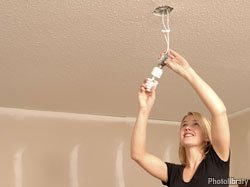
(ARA) – You’ve stopped buying bottled water, opting instead for a reusable bottle you carry everywhere you go. When you go shopping, your list leans toward the organic and recycled. But when you get home, going “green” seems a lot more daunting.
You hear stories about your ultra-conscientious neighbors trading their old energy-devouring water heaters and HVAC units for the new energy-efficient models, putting up solar panels and installing the dual flush toilets. Suddenly your effort to cycle out incandescent light bulbs starts to feel trivial.
And you start to wonder, if you are more confined by budget than your earth-friendly neighbors and pals, is going green worth it?
The trick is figuring out what works for you and your lifestyle, according to Mark Lewison, academic director of the Interior Design Department at The Art Institute of California – Hollywood. “Find an improvement that makes sense for your bottom line and then look for green options in that area of improvement.”
Reducing energy costs and decreasing wear on the planet over the long term is as easy as turning the lights down low. “That’s where you get the most bang for your buck,” says Joan Jackson, associate professor of interior design at The Illinois Institute of Art – Chicago. “Dimmers are cheap and extend the life of the bulb five to 10 times.”
Interior design associate professor Eve Fineman adds that a simple and inexpensive switch in the type of bulb you use makes an impact. “An LED light has a really long lamp life and draws much less energy.”
Jackson also suggests insulating your windows as a simple way to keep down costs and keep your home comfortable in both the cold and heat. And what’s the easiest way to conserve energy? According to Jackson it’s as simple as unplugging items when you’re not using them. “Most people don’t realize that your appliances are using energy when they’re plugged in, even when they’re off,” she says.
Going green is not just about saving energy and the outside environment. Your indoor air quality counts too. Fineman says the paint most of us used in the past was actually filled with volatile organic compounds (VOCs) that are bad for you to breathe in. That new paint smell was actually toxic. Luckily, most paint sold today has low or no VOCs.
If you do decide on more costly upgrades like energy-efficient appliances or sustainable and rapidly renewable materials like bamboo flooring, you can still see long-term savings, says Fineman. “Now there are ways to assess and compare your cost up-front versus how much the cost savings over a 10-year period will be,” she says. “Most of the time consumers see that it’s definitely worth the investment, because they’ll save a lot over the long term.”
“Any green or sustainable improvements that can be made to a home should increase a home’s value as a whole in addition to helping the owners save money,” Lewison adds.
All three experts agree, whether you’re trying to help your bottom line or the environment, the way to go is green.
To learn more about The Art Institutes schools, visit www.artinstitutes.edu/nz.





